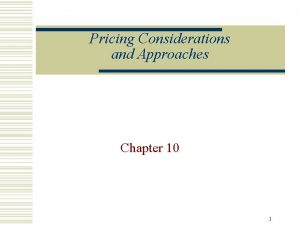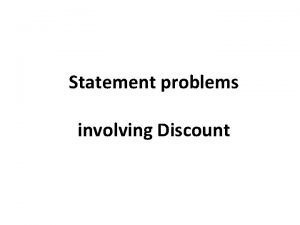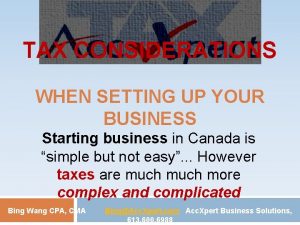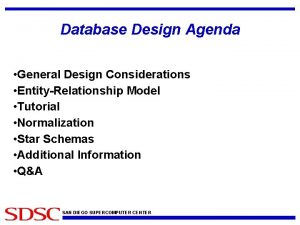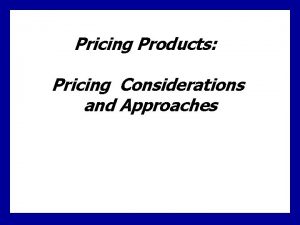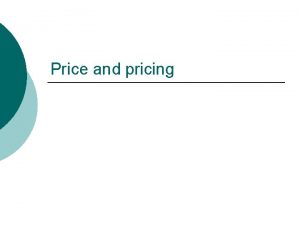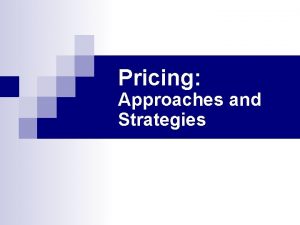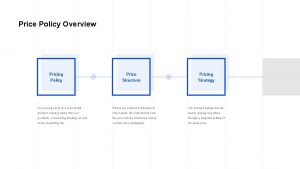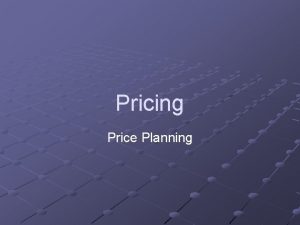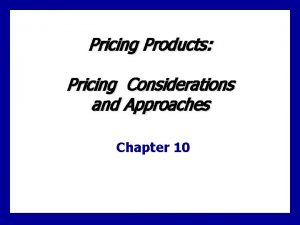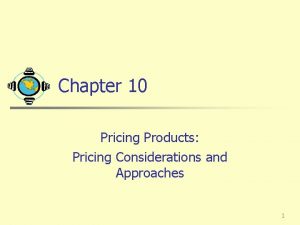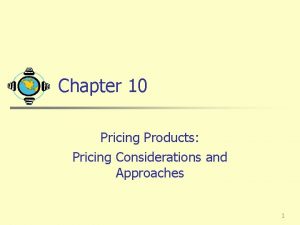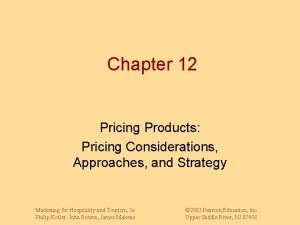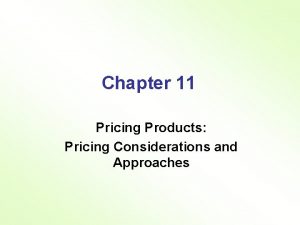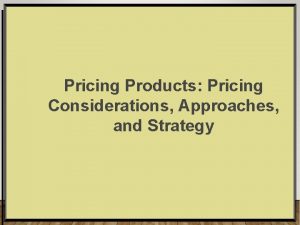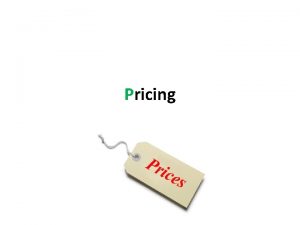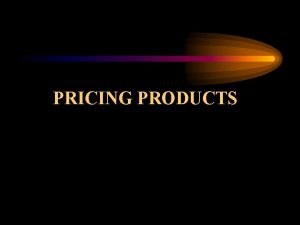Pricing Considerations and Approaches Definition Price The amount



















- Slides: 19

Pricing Considerations and Approaches

Definition • Price § The amount ofmoney chargedfor a product or service, or the sum of the values that consumers exchange for the benefitsof having or usingthe product or service. 10 - 1 Goal 1: Identify and define internal factors affecting pricing decisions

What is Price? Price Has Many Names • • • Rent Fee Rate Commission Assessment • Tuition • Fare • Toll • Premium • Retainer • Bribe • Salary • Wage • Interest • Tax 10 - 2 Goal 1: Identify and define internal factors affecting pricing decisions

What is Price? • Dynamic Pricing on the Web allows SELLERS to: § Monitor customer behavior and tailor offers. § Change prices on the fly to adjust for changes in demand or costs. § Aid consumers with price comparisons. § Negotiate prices in online auctions and exchanges. 10 - 3 Goal 1: Identify and define internal factors affecting pricing decisions

What is Price? • Price and the Marketing Mix: § Only element to produce revenues § Most flexibleelement § Can be changedquickly • Common Pricing Mistakes § Reducingprices too quickly to get sales § Pricing based on costs, not customer value 10 - 4 Goal 1: Identify and define internal factors affecting pricing decisions

Factors to Consider When Setting Price Internal Factors • Marketing objectives • Marketing mix strategies • Costs • Organizational considerations • Marketpositioninginfluences pricing strategy • Other pricing objectives: § Survival § Currentprofit maximization § Marketshare leadership § Productqualityleadership 10 - 5 Goal 1: Identify and define internal factors affecting pricing decisions

Factors to Consider When Setting Price Internal Factors • Marketing objectives • Marketing mix strategies • Costs • Organizational considerations • Pricing must be carefully coordinated with the other marketingmix elements • Target costing is often used to support product positioning strategies based on price • Nonprice positioning can also be used 10 - 6 Goal 1: Identify and define internal factors affecting pricing decisions

Factors to Consider When Setting Price Internal Factors • Marketing objectives • Marketing mix strategies • Costs • Organizational considerations • Types of costs: § Variable § Fixed § Total costs • How costs vary at different production levels will influence price setting • Experience (learning) curve affects price 10 - 7 Goal 1: Identify and define internal factors affecting pricing decisions

Factors to Consider When Setting Price Internal Factors • Marketing objectives • Marketing mix strategies • Costs • Organizational considerations • Who sets the price? § Small companies: CEO or top management § Large companies: Divisional or product line managers • Price negotiation is common in industrial settings where pricingdepartments may be created 10 - 8 Goal 1: Identify and define internal factors affecting pricing decisions

Factors to Consider When Setting Price External Factors • Nature of market and demand • Competitors’ costs, prices, and offers • Other environmental elements • Types of markets § Pure competition § Monopolistic competition § Oligopolistic competition § Pure monopoly • Consumerperceptionsof price and value • Price-demand relationship § Demand curve § Price elasticity of demand 10 - 9 Goal 2: Identify and define external factors affecting pricing decisions

he Market and Demand Factors that Affect Pricing Decisions P u r e C o m p e ti ti o n Many Buyers and Sellers Who Have Little Affect on the Price. Mo n o p o l i s ti c C o m p e ti ti o n Many Buyers and Sellers Trading Over a Range of Prices. Different Types of Markets Oligopolistic Competition Few Sellers Each Sensitive to Other’s Pricing/ Marketing Strategies Pure Monopoly Single Seller 10 - 10

Price Demand Curves A. Inelastic Demand Hardly Changes With a Small Change in Price. P 2 P 1 Price Q 2 Q 1 Quantity Demanded per Period B. Elastic Demand Changes Greatly With a Small Change in Price. P’ 2 P’ 1 Q 2 Q 1 Quantity Demanded per Period 10 - 11

Factors to Consider When Setting Price External Factors • Nature of market and demand • Competitors’ costs, prices, and offers • Other environmental elements • Consider competitors’ costs, prices, and possible reactions • Pricing strategy influences the nature of competition § Low-price low-margin strategiesinhibit competition § High-price high-margin strategiesattract competition • Benchmarking costs against the competition is recommended 10 - 12 Goal 2: Identify and define external factors affecting pricing decisions

Factors to Consider When Setting Price External Factors • Economic conditions § Affect production costs § Affect buyer perceptions of price and value • Nature of market and demand • Resellerreactions to prices must be considered • Competitors’ costs, prices, and offers • Government may restrict or limit pricing options • Other environmental elements • Social considerations may be taken into account 10 - 13 Goal 2: Identify and define external factors affecting pricing decisions

General Pricing Approaches • Cost-Based Pricing: Cost-Plus Pricing § Adding a standardmarkupto cost § Ignores demand competition § Popular pricing technique because: • It simplifies the pricing process • Price competition may be minimized • It is perceived as more fair to both buyers and sellers 10 - 14 Goal 3: Contrast the three general approaches to setting prices

General Pricing Approaches Cost-Based Pricing Example - Variable costs: $20 - Fixed costs: $ 500, 000 - Expected sales: 100, 000 units - Desired Sales Markup: 20% Variable Cost + Fixed Costs/Unit Sales = Unit Cost $20 + $500, 000/100, 000 = $25 per unit Unit Cost/(1 – Desired Return on Sales) = Markup Price $25 / (1 -. 20) = $31. 25 10 - 15 Goal 3: Contrast the three general approaches to setting prices

General Pricing Approaches • Cost-Based Pricing: Break-Even Analysis and Target Profit Pricing § Break-even charts show total costand total revenuesat different levels of unit volume. § The intersection of the total revenue and total cost curves is the break-even point. § Companies wishing to make a profit must exceed the break-even unit volume. 10 - 16 Goal 3: Contrast the three general approaches to setting prices

General Pricing Approaches • Value-Based Pricing: § Uses buyers’perceptions of value rather than seller’s costs to set price. § Measuring perceived value can be difficult. § Consumer attitudes toward price and quality have shifted during the last decade. § Value pricing at the retail level • Everyday low pricing (EDLP) vs. high-low pricing 10 - 17 Goal 3: Contrast the three general approaches to setting prices

General Pricing Approaches • Competition-Based Pricing: § Also called going-rate pricing § May price at the same level, above, or below the competition § Bidding for jobs is another variation of competition-based pricing • Sealed bid pricing 10 - 18 Goal 3: Contrast the three general approaches to setting prices
 Pricing considerations and approaches
Pricing considerations and approaches Ito ay kilala bilang maximum price policy
Ito ay kilala bilang maximum price policy General pricing approaches
General pricing approaches Pricing approaches
Pricing approaches Operational considerations definition
Operational considerations definition Price discovery and price determination
Price discovery and price determination Writing strategies and ethical considerations
Writing strategies and ethical considerations Ethical issues in experimental research
Ethical issues in experimental research Marked price-selling price=
Marked price-selling price= Hire purchase system and installment system
Hire purchase system and installment system Chain conveyor shot blasting machine
Chain conveyor shot blasting machine What are the general considerations in machine design
What are the general considerations in machine design Tax considerations for setting up a new business
Tax considerations for setting up a new business Emv kiosk considerations
Emv kiosk considerations Three considerations of societal marketing concept
Three considerations of societal marketing concept Mechanical considerations of transmission line
Mechanical considerations of transmission line Database design considerations
Database design considerations Compare and contrast first and second language acquisition
Compare and contrast first and second language acquisition Cloud delivery models
Cloud delivery models Basal state blood collection
Basal state blood collection


